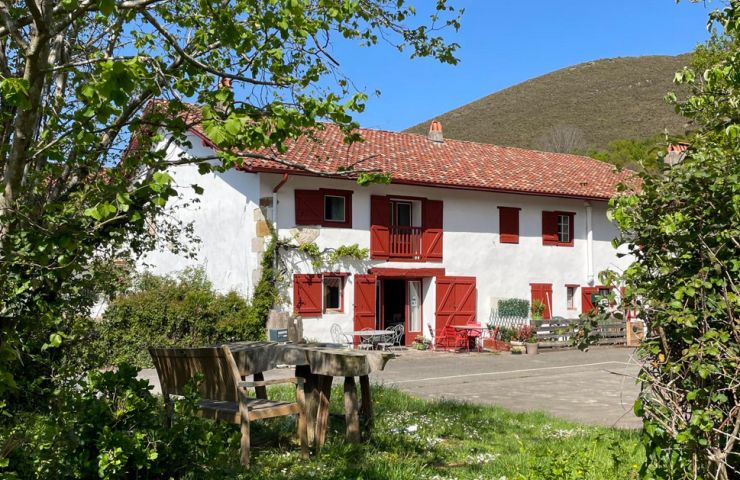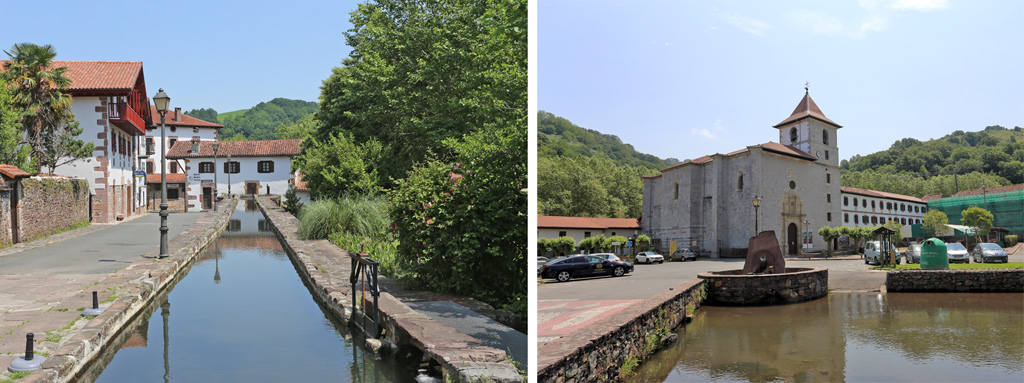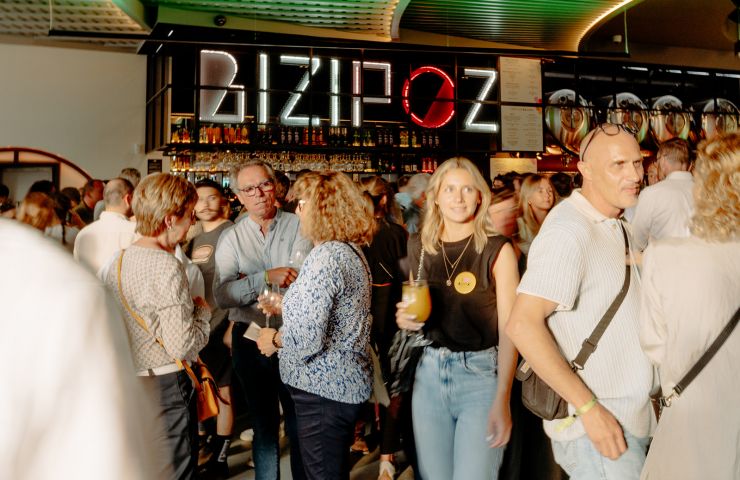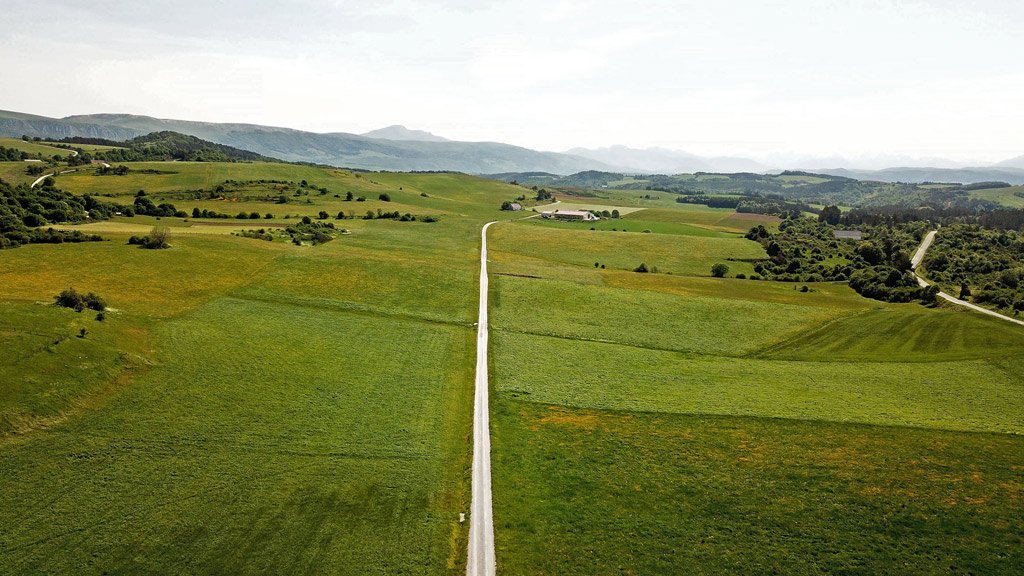- Home page
- Tourism
- Discover
- Visiting the Basque Country
- [Spanish Side] Navarre - The North of Navarre, the Pyrenees, the Valleys
- Visiting the Basque Country
- Discover
- Tourism
Navarre - The North of Navarre, the Pyrenees, the Valleys
Automatic translation
The Bidassoa (Bidasoa) is a coastal river that rises in the Western Pyrenees Mountains in Navarre and flows into the Bay of Biscay between Hendaye and Hondarribia. From Erratzu, its fish-filled waters are filled with small rivers and torrents, at this point, its name is not the same: Baztan. Its valley, in the northwest of Navarre, offers a softened geology, where watercourses meander between the mountains, throwing themselves quite abruptly towards the sea, as if to plunge into it. Green, rich and dotted with quiet little roads, these valleys are dotted with villages with striking viewpoints.
Elizondo
The journey begins in Elizondo, the capital (chief town) of Batzan. It is a lively and popular town with typical houses where sometimes, at the bend of a street, a more illustrious architecture of beautiful mansions mixes. Wooden balconies and glowing stone walls rub shoulders with other buildings, memories of the American occupation of the post-war years.
- In Elizondo, don't miss the viewpoints over the river, the Baztan, and its uneven aesthetic. The Tourist Office organizes guided tours, but you can go to the Txokoto neighborhood yourself, the main architectural attraction.
- The Ethnographic Museum of Baztan is an interesting stop to learn more about life in the region.
- Near the town, don't miss the Sentier du Ruisseau "Inferno" where there is an old restored mill, a beautiful walk, sometimes a little steep, which is worth the detour.
- Those who enjoy walking will also be happy to walk to the Xorroxin waterfall from the Gorostapolo chapel.
- A little further, 7 kilometres away, towards Oieregi, don't miss the Señorio Natural Park with an arboretum and a botanical garden, a great family walk.
In Elizondo, it's party time around July 25th! Dances, costumes and music are out for the patron saint's festivities: Baztandarren Biltzarra.
Gîtes de France 64
Gîtes de France 64
With more than 1,200 Gîtes de France-certified accommodations, Béarn and the Basque Country are full of authentic ...
Bayonne
Gîtes de France 64
Gîtes de France 64
For those who want to discover life on a farm, but also the Basque Country through the diversity of agriculture and ...
Bayonne
Gîtes de France 64
Gîtes de France 64
Gites de France campsites You will be able to enjoy the joys of nature in a friendly atmosphere, and leisure ...
Bayonne
In the Baztan Valley
- Going up the Baztan, Erratzu is a very pretty flowery village with jovial inhabitants.
- Arizkun to the west is nestled in the valley. There you will visit the Santxotena museum and its wood carvings. You will stroll through the pretty streets and see the San Juan Bautista church.
- Going up towards Urdazubi to the north, on the right, stop at Maya / Amaiur, just for the pleasure of crossing its unusual arch ! As in the entire region of the Baztan Valley, the houses are built with stones from the Almandoz quarries, characteristically red. Climb to the top of the mountain to see the ruins of the castle, the monolith and the beautiful view! At the entrance to the village there is an old mill, renovated and open to visitors. You can even buy something to make bread or corn cakes (Talos).
Urdazubi, park and caves
In Urdax/Urdazubi there is an imposing building, it is a monastery. In this tidy and quiet village, very close to the border with France and crossed by the river, there is also a mill and from it, the view of the monastery San Salvador is beautiful.
Not far from the village, will you dare to go to the Urdax Caves ? A long time ago, they were thought to be inhabited by mythological beings (the Lamink), protectors of the underground river that is there. Today, they are open to visitors.
Near the village there is an animal park where you can see Bengal cats and birds of prey. Shows are held in season, inquire on site at the Parque Trikuharri de Fauna Halcon.
To the northwest of Urdazubi, there is the village of Zugarramurdi and its witches' caves, with their past, tinged with secret meetings... To see!

Urdazubi
The valley of the “ Cinco Villas ”
Etxalar is the village of wood pigeon hunting. It is a tradition of this locality, which does not fail to animate it in autumn (the 3rd Sunday of October), when the special hides (the Fuies) are set up and the eyes sharpen.
Stop on the road to France, about 8km away, there is the forest where the famous "Fuies" are installed.
In November, after the hunt, it's gastronomy that takes centre stage and lovers of migratory game will be licking their lips...
We continue the discovery of the valley with Bera, the last of the 5 towns of the valley of the " Cinco Villas ". Discover the church of San Esteban, the town hall and its arches, the beautiful villas that belonged to wealthy families.
Not far from the border, there is also Lesaka, which brings us closer to San Sebastian. It is a city that has had significant industrial importance in the region: forge, mill... In the city center, old and beautiful houses attest to the city's fertile economic past. Stroll through Lesaka, appreciate the beauty of its buildings, the Gothic touches, the stone bridge, the towers and the fortified houses. There is also the church of San Martín de Tours , imposing and unique alternating between Gothic and Baroque.
Around the town, there are hikes and in particular visits to dolmens in the Agiña Megalithic Station.
Don’t miss it!! The Bidasoa Greenway, for cycling enthusiasts! Hours of fun and leg workouts…
Malerreka, Zubieta and Leitza Valley
Looking for relaxation and well-being? South of the Bidasoa Valley is a pretty little spa resort renowned for its very salty waters in the hollow of the mountains. Hydrotherapy, pools, sauna, hammam are on the program. The facilities are qualitative but simple and are not intended to compete with the more imposing border resorts. If you are looking for balance, harmony and well-being in a quiet place, this is perfect!
Just a few kilometres away, discover the small village of Doneztebe in the Malerreka Valley, famous for its cattle fair and its San Pedro church. This pretty valley located in a rural area, boasts a mild climate, numerous oak and beech forests and the beauty of the Leurtza reservoirs (classified as a Natural Recreation Area). An ideal place for a nature retreat, family holidays with walks (3 and 9 kilometres), barbecues and the pleasure of dipping your feet…
In Zubieta , take a tour of the eco-museum in the old grain mill.
The last week of January, the city (as well as nearby Ituren) comes alive with a beautiful, colorful and joyful carnival, accompanied by the sound of cowbells (the bells of the region's cows).
Go down to Leitza via the Usateguieta pass, a pleasant road that ends in a town with a lot of sporting activity. Here, Basque Force is widely practiced, as well as pelota. Basque Force is a series of sporting events that pay tribute to the tasks linked to the harsh living conditions of the past. These are jobs that require strength, agility and also knowledge of how to use tools such as the axe, saw and pitchfork. A famous practitioner, Iñaki Perurena, has also created a museum in Leitza, the Peru-Harri, around the stone, where you will learn more about Basque culture in general.
Larraun Valley
Lekunberri is a village that positions itself as a pleasant place of passage and vacation to explore the Sierra Aralar, its 200km2 of valleys, caves, dolmens, mills, chapels and green forests. All reasons and seasons are good to come and walk there. The deciduous forests play with their colors to the rhythm of the seasons. In winter, the absence of leaves offers beautiful light and nice viewpoints.
From the Larraun Valley, the hikes are qualitative and numerous. Head towards the remarkable Sanctuary San Miguel d'Aralar at some 1130 m altitude, offering a superb soothing view.
From Lekunberri, it is also interesting to get on your bike and ride the Plazaola greenway that goes to Andoain along an old railway line of about 45 kilometers. Low gradient, beautiful landscapes and picturesque heritage elements.
Sakana and Ultzama Valley
Altsasu is a city at the heart and crossroads of the different Basque provinces. Here the Basque spirit (and heart) is very perceptible.
- The Sakana Valley is located between the surrounding Sierras, Aralar and Urbasa. This is where the city is nestled and there are beautiful hiking trails for these two mountains. It is picturesque and dotted with small heritage elements (shelters, low walls).
The Alsasua carnival is famous, rich in symbols, lively and people come from far and wide to attend it.
2018 made the city and the region infamous for the political affair and trial of the " Alsasua 8 ", which stirred up opinion and divided against a backdrop of independence demands.
The Urbasa Natural Park extends to the Pamplona region over 28 hectares. It is in Baquedano that beautiful hikes await you.
- The Ultzama Valley is north of Pamplona and touches the Baztan. It is a region with few tourists, which is pleasant to explore if you like horse riding, nature, contemplation. Small villages as if stopped in time, which savor the life that flows by… Lovers of pedunculate oaks will go see the Orgi forest which promises a serious journey through time since it is very preserved on 80ha.
If you like mushrooms and in particular porcini mushrooms, those familiar with picking can, in season and completely legally, sharpen their knives and go in search of the precious mushroom for the (reasonable) price of a small permit legalizing the picking.
Zubiri, Erro and Auritz
To the east, we find Zubiri (and its pretty medieval bridge), Erro which are towns at the entrance to the Roncesvalles valley. Natural places, we find restaurants and inns there, since we are on the road to Santiago de Compostela.
Note, this is a corner of paradise for fishermen, who are on the Rio Arga leading to a reservoir further north.
Auritz (Burguete), territory classified as a Site of Cultural Interest, is wild and tinged with pilgrimage! The village is surrounded by a beautiful mountain panorama. It is a town formerly attached to Roncevaux (Orreaga/Roncesvalles) a little further north.
A historic site, it is nestled in a valley surrounded by cliffs and a superb natural setting, worth the detour in itself. On August 15, 778, Charlemagne's army, led by the knight Roland, was defeated there
Passing the Pass and studying the geography, we understand why. It is an important stage of the pilgrimage to Santiago. There we will see the Gothic-style Collegiate Church, the monastery and a small museum of religious objects.

The Zubiri Bridge
Orbaizeta, the valley of Irati and Aezkoa
Going back up towards the French border, there is Luzaide (Valcarlos) also linked to the battle of Roncesvalles. There you will see a church of St. James: Santiago Apostol. During the Carnival festivities, you will enjoy the Bolantes de Luzaide, a show of cultural and local dances, where the performers wear pretty costumes with bells.
Orbaizeta, the Irati Valley is pleasant when you walk along the NA 140 from the Roncesvalles Valley. There you can visit the amazing old royal arms and munitions factory from the 18th century. Beautiful remains are visible, covered in moss, waiting to be awakened, not far from the Irati Forest, rich in waterways and iron ores in its subsoil.
Not far away, Aribe, which is in the Aezkoa Valley, is home to the highest municipalities in Navarre. Splendid forests, houses grouped in small villages with red tile roofs. On the road to Oroz-Betelu, There are very beautiful views of the Pyrenees.
The amazing Stelae Museum and its intriguing labyrinthine walls are located in Abaurregaina, next to the church. In the Irati forest, you will see the megalithic station of Azpegi that is reached from Orbaizeta after a 3km walk. A " fold " formed by several sedimentary layers of the mountain, not far away, forms the Arpea cave.
Ochagavia, Roncal Valley, Erronkari
It is said that Ochagavìa is the most beautiful village in this region of Navarre. A real postcard, colorful and picturesque, which will certainly seduce you. Small medieval bridge, beautiful houses, steep red roofs and perfectly aligned landscapes. Visit the church of San Juan Evangelist, put on your sneakers and go to the Sanctuary of Nuestra Señora de Muskilda. Right at the border between France and Spain, climb (it is not very long or difficult), the peak of Ori to the north of the Salazar valley, which is said to be the home of a goddess: Mari who protects the spirits of nature.
Heading south and the Roncal Valley, you will find Isaba. In winter, the village and its steep roofs are covered in snow, it is very beautiful. Visit the church-fortress of San Cipriano and the House of Memory of Isaba, an ethnographic center to learn more about the customs and traditions, the lifestyle of this region. Cross-country skiing is a popular activity in winter.
You arrive at the Roncal-Erronkari valley, which marks the eastern limit of the Basque Pyrenees mountains. You surely know Roncal cheese, which is delicious thanks to the green pastures where the animals graze, which gives its exquisite taste to the sheep's milk (in August, there is the cheese day, not to be missed...). In these valleys where we get closer to Béarn, a whole string of cute and picturesque little villages await you. Cross-country skiing enthusiasts will be in their element. High peaks to explore, good gastronomy to discover, water is also present and has carved out the contours of the landscape.
Towards Burgui, you will see magnificent gorges in an area classified as a Nature Reserve. There is also a very pretty Roman bridge, and a sort of port from where the trunks of lumbered wood were transported in the valley. There is also a 4 km trail that presents the trades of yesteryear, a sort of very interesting ethnographic walk. Don't miss the Wood Train Day, which highlights the incredible journey of logging in this region (end of April, beginning of May). It was in log rafts that the loggers descended the rivers, in their tumultuous waters, to transport their precious cargo.
Let's go back to Roncal, where there is a mausoleum in homage to Juliàn Gayarre, a tenor and singer from Navarre: a magnificent sculpture by the artist can be seen in the cemetery. Not far from the church, there is a museum dedicated to him with objects retracing his life. A Nature Interpretation Center is also worth visiting, where you will understand the place of Man in these large forest valleys, dotted with generous waterways and rich ecosystems.
Having had your fill of nature, do you fancy a city break ? Head to the capital of Navarre, the city of Pamplona !
Venta Biok
Venta Biok
BIOK Experiential Shopping - Quality at the best price Welcome to BIOK Shopping Centers! Located in the charming ...
Urdax
Venta Peio
Venta Peio
Located in a privileged natural setting, Ibardin has established itself as one of the most complete shopping areas ...
Bera
Bizipoz bar
Bizipoz bar
Discover the Bizipoz Bar, your new unique place to live on the Basque Coast! The BIZIPOZ BAR is an intergenerational ...
Saint-Jean-de-Luz
OUR CITY GUIDES IN EUROPE

















